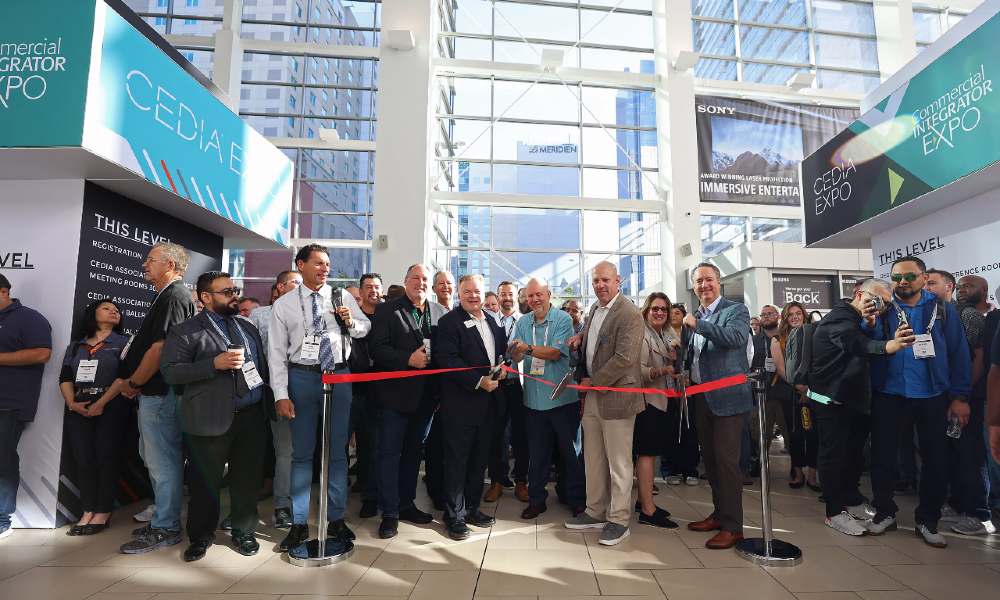
Key Takeaways: CEDIA Expo and Commercial Integrator Expo
There’s no doubt that there is an increased interest in attending trade shows, conferences and events at which members of the AV community can get together to catch up; talk about business and technology trends; collaborate on ideas and solutions; and enjoy each other’s company. Whether or not manufacturers and vendors have a new product to promote, technology to showcase or any other reason to wow attendees, nothing beats the face-to-face meetings and casual conversations that would otherwise be difficult to happen through other means.
Value of In-Person Interactions
It is undeniable how much work it can take to get an email response, schedule a video meeting, or get a hold of someone by phone. While at a trade show or event, everyone is there to see each other, be seen, make connections and catch up on the buzz of the industry.
Aside from a valuable occasion to convene, the recent CEDIA Expo and Commercial Integrator Expo trade show provided a unique opportunity to demonstrate the synergies between the residential and commercial areas of the AV industry.
While there are distinct differences within the project nuances, design aspects, and user expectations within residential and commercial systems; the consistencies of AV principles, signal-flow knowledge, control-programming fundamentals, prevailing technologies and trending themes persist across both markets. These commonalities are also indicative within the messaging of exhibitors, interest of attendees and topics of conversation held throughout the events.
Prevailing Opportunities
Industry trade shows and events throughout the year have pointed to several common themes in response to changing business philosophies, strategic initiatives and market needs.
- A preference for open ecosystems and interoperability rather than walled gardens and proprietary solutions.
- A desire for flexible options and substitutable devices rather than being limited to a particular technology, product or brand.
- A receptiveness to new products, solutions or approaches.
- A move from competitive boundaries and silos to increased collaboration amongst manufacturers and solutions providers.
CEDIA Expo and Commercial Integrator Expo offered a unique opportunity to affirm a general consistency of these themes regardless of market segments, system types, client specificities, and manufacturer types. These trends bode well in all markets and speak to a bright future for AV integration, an increased importance of systems integrators, and a greater emphasis on the value of programming. They also provide a guiding light for those who position themselves to capitalize on what have become hot-button topics and pivots in the industry.
As manufacturers continue to demonstrate their receptiveness to clients’ needs for increased product compatibility; they are taking action to think past the scarcity mentality of owning the end-to-end solution or protecting their market share with barriers that prevent competition from being included in their projects or ecosystem.
An example of this shift can be seen in the open-mindedness of control system platform manufacturers who are broadening their driver, module and plugin libraries beyond strategic alliances to include rival manufacturers and products that compete in the same markets and/or categories.
Similarly, third-party manufacturers are touting their products’ published APIs (Application Programming Interface), connectivity with complementary devices, and affiliations with control platforms through pre-developed API middleware (modules, drivers, plugins, software, etc.).
This move demonstrates an increased focus on ease of integration, the importance of control capabilities and the value of compatibility with a wide variety of products that increase their reach and marketability while providing confidence that clients will not be limited in the possibilities in which their product can be implemented.
Expanding Business Operations
For integrators, it is important to become skilled and familiar with a variety of options that can be offered to clients. Specializing in a singular brand, technology or solution may have been an effective strategy in years past; however, clients have learned that they do not want their future to be limited by product availability, proprietary technologies or offerings that may not be the best fit for their specific needs.
A move toward product alternatives also means a greater demand for customized solutions that require skilled design, installation, and programming services. All of this plays into the strength of full-service integrators or encourages partnerships between integrators and specialty service providers.
With the increased emphasis on making disparate products work together, the importance of programming and programmers becomes even more critical. Programmers have the opportunity to shine as they hold the key to the ease of system operation for users who rely on seamless functionality regardless of the system complexity and products being integrated behind the scenes.
Working with manufacturers who understand the needs of programmers and provide the tools, capabilities and support that fuels their success will in turn provide increased benefit to clients.
Concluding Thoughts
It should be no secret that the AV industry has undergone recent changes resulting from strong client sentiment for product options and the need to satisfy project requirements in new and creative ways spurred on by the impact of the pandemic and supply-chain challenges. And those who attend trade shows and events like CEDIA Expo and Commercial Integrator Expo have the opportunity to witness the impact of these changes on the industry at large. They also get to learn, so they can take action to adapt quickly; they’re privy to those vital in-person conversations; and they get a leg up on competition who aren’t in attendance.
A decision to abstain from trade shows and industry events, no matter the size, focus or attendance, is a missed opportunity to connect, collaborate, observe trends, adapt to changing needs and prepare for a successful future.
- Posted In:
- Media


